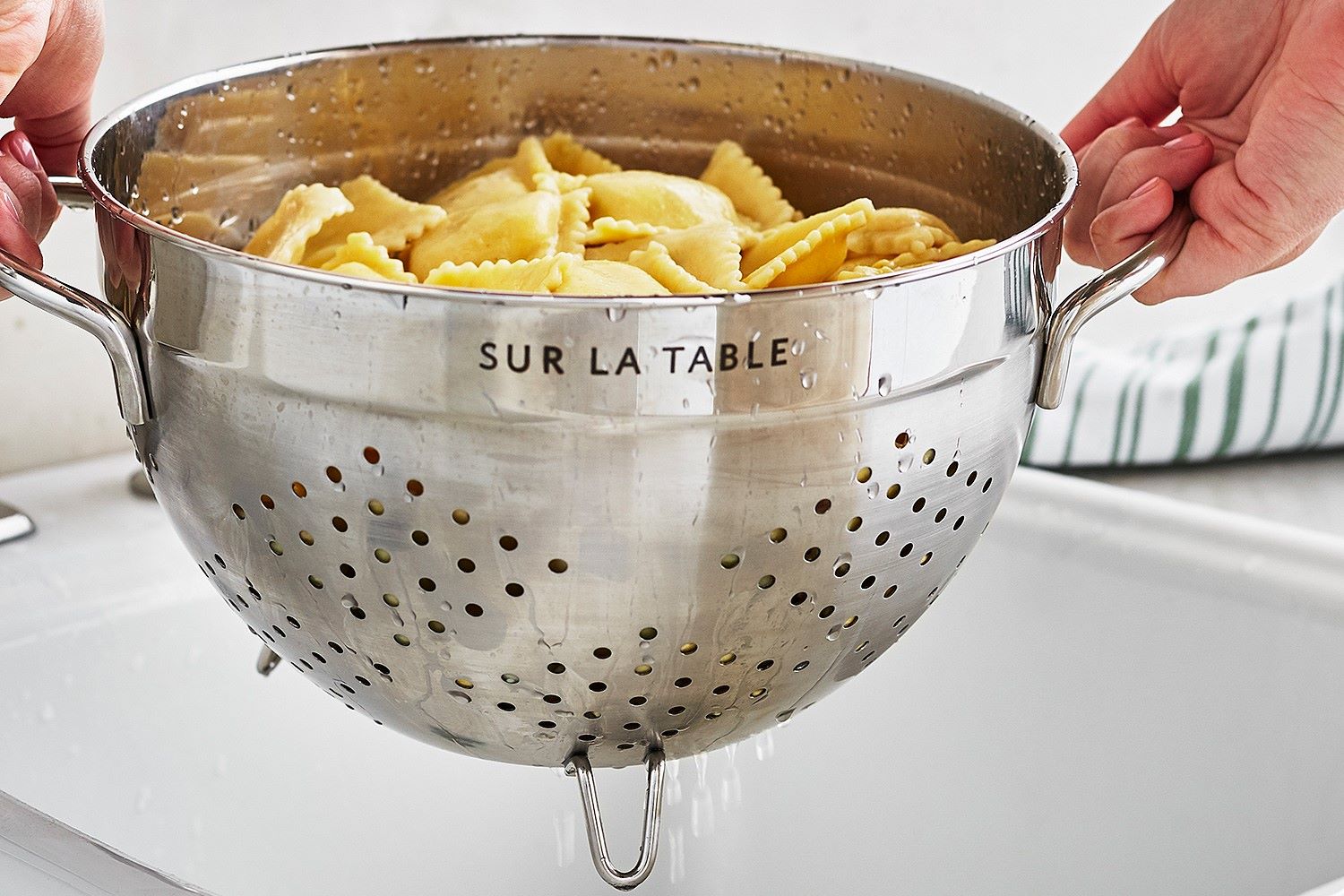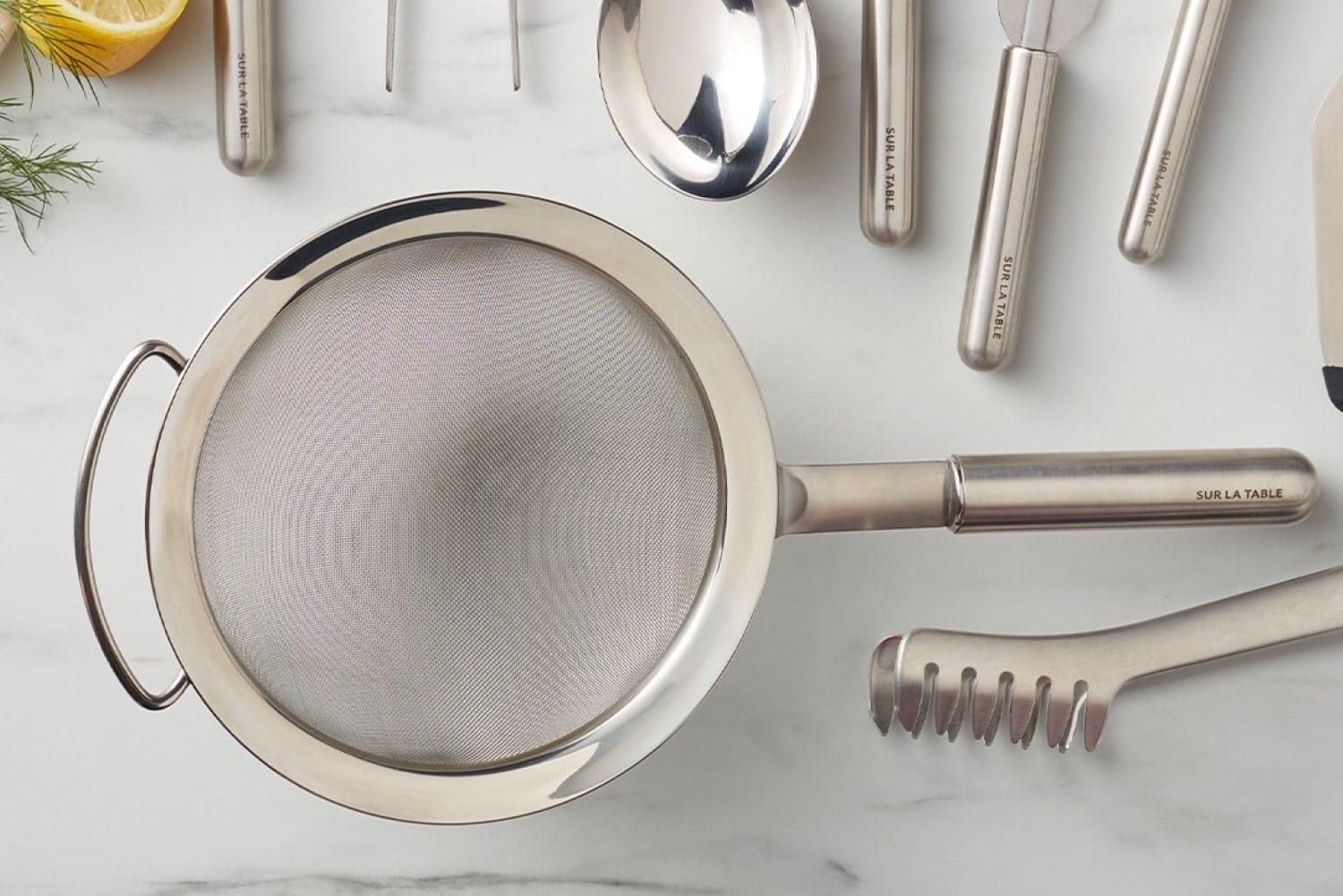Decisions, decisions.


Most kitchens have a sieve or a colander tucked behind the pots and pans, but to many people’s surprise, they do more than strain pasta water. While they may look interchangeable, they’re designed for completely different tasks.
A sieve has a fine mesh strainer and is typically used for aerating things like flour or sugar. A colander has a perforated bottom and is used to rinse foods or drain liquids.
We’ll walk you through their differences, link our faves and show you how to get the most out of these unassuming kitchen must-haves.
Hungry for more? Explore our cooking and baking essentials!

In addition to draining water from cooked pasta and grains, colanders are the perfect tool for rinsing produce.
The perforated bottom of a colander allows liquid to drain through while retaining the solids inside its bowl-like shape. Traditionally, colanders are made of a light metal like stainless steel, but you can find them in a range of materials from plastic to silicone.
Strain Cooked Pasta
This is probably the most well-known use for a colander. The holes and stable base allow you to place your colander in a clean, empty sink and pour the pasta into it
Rinse Produce
Washing your produce is super important.
Raw fruits and vegetables can contain harmful germs like as salmonella, E. coli and listeria. The USDA estimates that germs on fresh produce cause approximately 46% of foodborne illnesses in the United States. So, make sure to wash your fruit before chowing down on it.
Because of its wide, stable base and perforated bottom, it’s ideal for rinsing smaller produce, like berries, grapes or tomatoes.
Drain Canned Food
When you want to keep the liquids as well as the solids, whether it be reserving pasta water or the liquid from canned food items like beans, simply place a colander above a larger bowl, pour the canned food into the colander, and allow the liquids to drain out into the bowl.
Then you can set aside the liquid you want to save and rinse the food in the colander. This allows you to reserve the liquid while still cleaning or washing your food.
Steam Vegetables
If you don’t have a steamer basket, you can use a colander to steam vegetables or fish. Simply place the colander over pot filled with water that’s lower than the bottom of the colander. Cover with a lid and let the steam do its trick.
Chef’s Note: This trick only works with heat resistant materials, like metal or silicone.

The humble sieve is not only great for sifting flour but also for rinsing and draining small foods, like rice and quinoa, that you might otherwise lose through the larger holes in a colander.
A sieve typically has a fine mesh net or perforated sheet material that aerates dry ingredients like flour and sugar for a lighter cake texture. It can also be used to remove seeds from a fruit coulis or make a smooth puree.
Sift Dry Ingredients
Flour and other dry ingredients often get compacted during shipping, which can cause lumps in packaging. So, a lot of bakers like to sift their dry ingredients, which not only removes those lumps, but also adds air for fluffier baked goods.
Simply toss your dry ingredients into to a fine mesh sieve and then shake it gently in a side-to-side motion over your mixing bowl—and voilà!—the start to a delicious dessert.
Rinse Small Foods
Rice and quinoa often need to be rinsed before you cook them, but a colander’s holes are too big. In this case, you’d need a sieve.
Place your grains in its fine mesh basket, run it under a gentle stream of water and shake the sieve gently to help speed up the process.
Strain Sauces
A lot of professional chefs like to use a type of sieve called a chinois, or conical strainer, to strain foods by hand and get lumps out of a gravy or sauce.
The main difference between a sieve and a conical strainer is the shape of the mesh basket. A conical strainer has a cone-shaped basket instead of a sieve’s round-shaped basket. To use something like this, you’d place the food you want to strain into the conical strainer, hold it over a bowl and push the gravy or sauce through the mesh with a wooden spoon.
Fine mesh strainers can be a pain to clean.
We’ve found that the best time to clean one is as soon as you’re finished using it. Shake off any excess from the mesh into the trash, run the sieve under hot water and make sure to rinse both sides really well.
From there, you can wash it like any other kitchen utensil with hot water and dish soap. You can also use a soft scrub brush to release any stubborn particles from the mesh.
Hungry for more? Explore our cooking and baking essentials!
JOIN THE CONVERSATION